H. D. wrote last week asking for some Florida garden consulting. Here are a couple of photos of what she’s done so far:
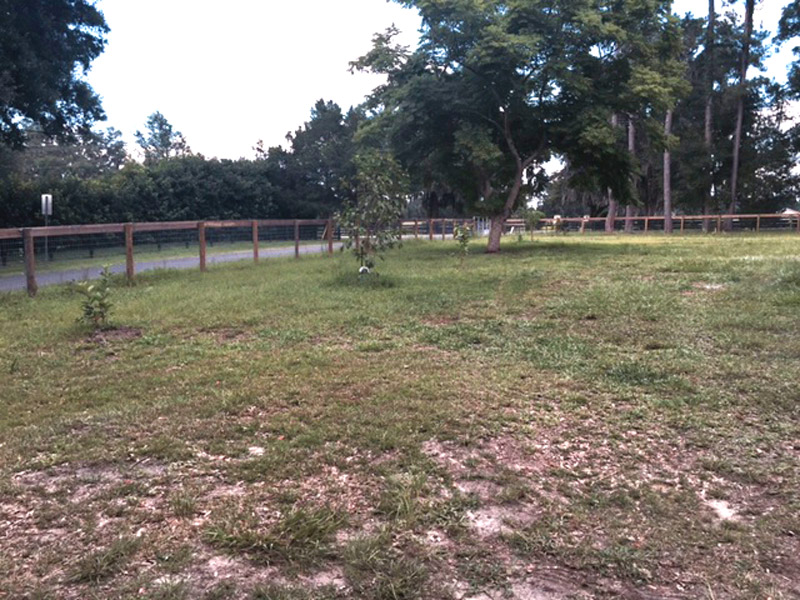
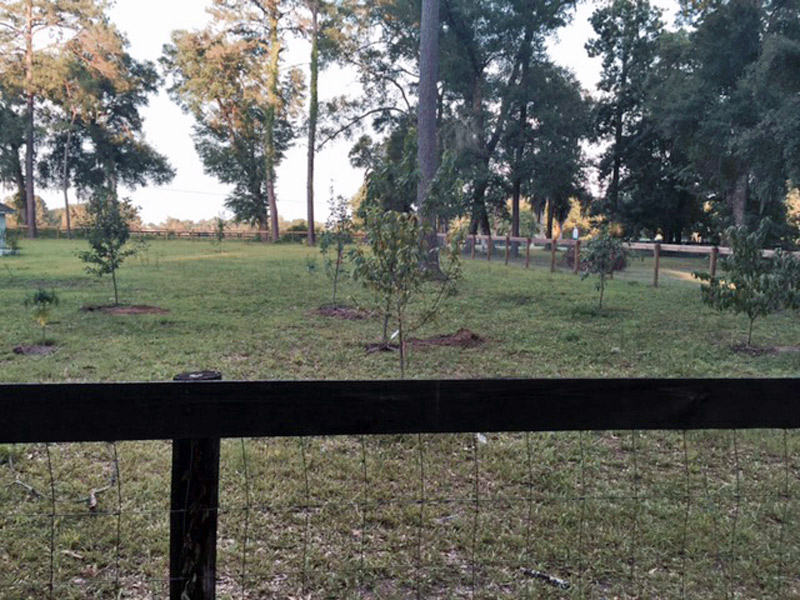
Since there’s a lot to cover here, I will interject my answers in between her questions:
“Hi! I bought all of your available books to date [thank you!] but I am in desperate need of your opinion.
I have been turning 1 and a half acre into a food farm over the past year. I have planted:
2 kumquat
1 loquat
3 persimmon
3 mulberry
4 banana
4 fig
2 pomegranate
3 guava
2 papaya
4 peach
1 avocado
1 cherry of Rio Grande
1 traditional cherry
2 apple
1 meyer lemon
2 honey mango
and 2 pecan trees.
I am located in Ocala and have decent soil.
You will have some trouble with a few of those selections in your area. Though Ocala isn’t the coldest spot in the state, it’s definitely out of mango range, unless you have some very good microclimates in the yard. You will likely lose the guavas to frost as well, unless they’re cattley guavas like this one:
I tried true tropical guavas on my previous homestead and they couldn’t take the Ocala winters. Papaya will die as well unless they’re right next to the house.
One more thing: if you have a traditional cherry tree, it probably needs a pollinator. I’m not aware of any self-pollinating true sweet cherries. Also, there are only two types that allegedly will grow in Florida: “Minnie Royal” and “Royal Lee” – they pollinate each other. Unless it’s a black cherry (Prunus serotina), which is suited to the area.
Back to the questions:
“I am spacing everything out and have based my layout on the anticipated size of each tree/shrub. I am concerned that I need other plants to help avoid certain issues with the plants I am growing or to complement them.
Also, I would like any suggestions as to what beneficial plants/trees/shrubs you feel that I should have that will grow here??
Certain books, videos, anything… any and all advice is and will be greatly appreciate. I would love a food forest but my other half is one of those people that likes things perfectly uniform and as a result, I have to put my trees and plants in locations that he can live with.”
The Current Plan
H. D. sent me the current plan for her homestead, along with a plant species key:
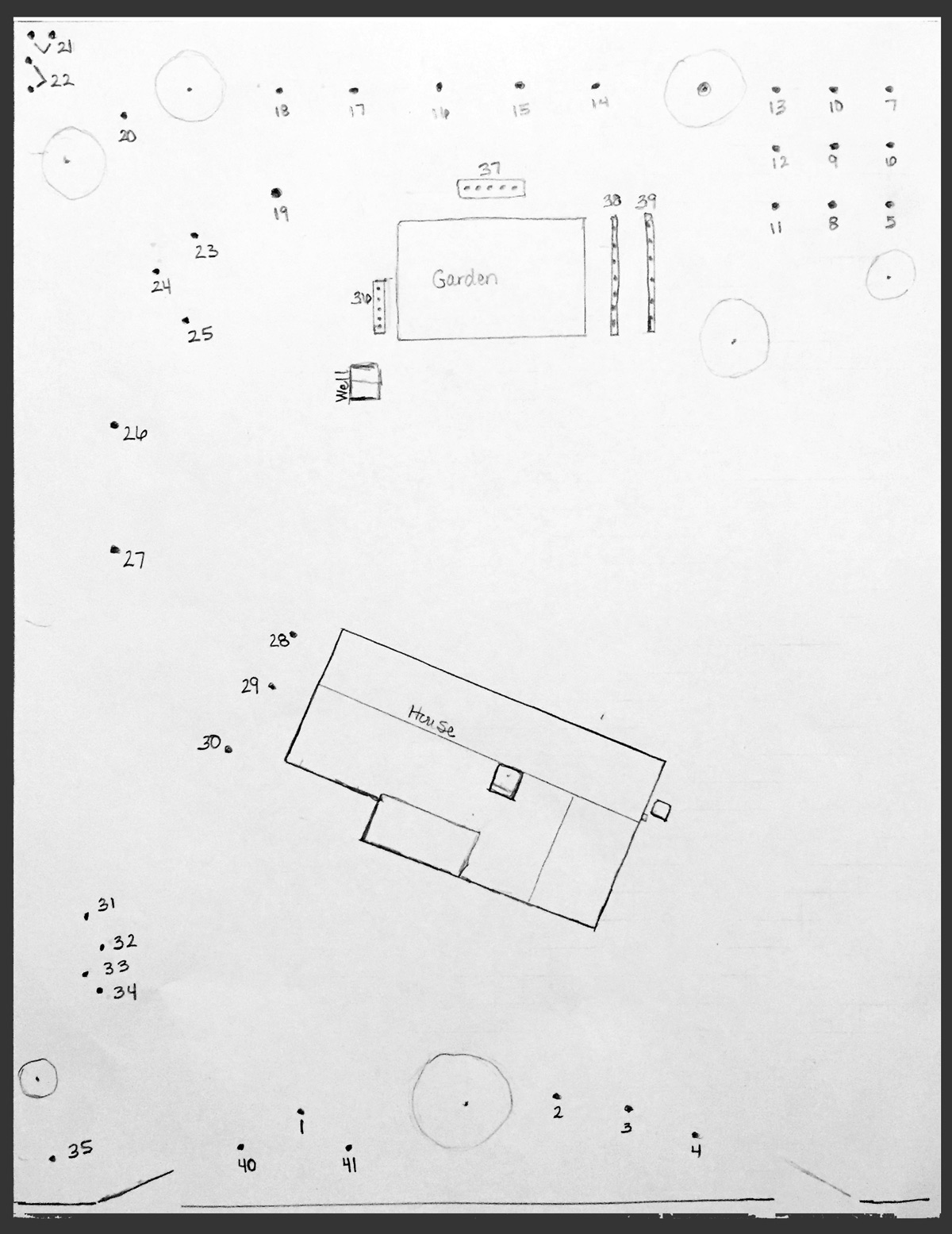
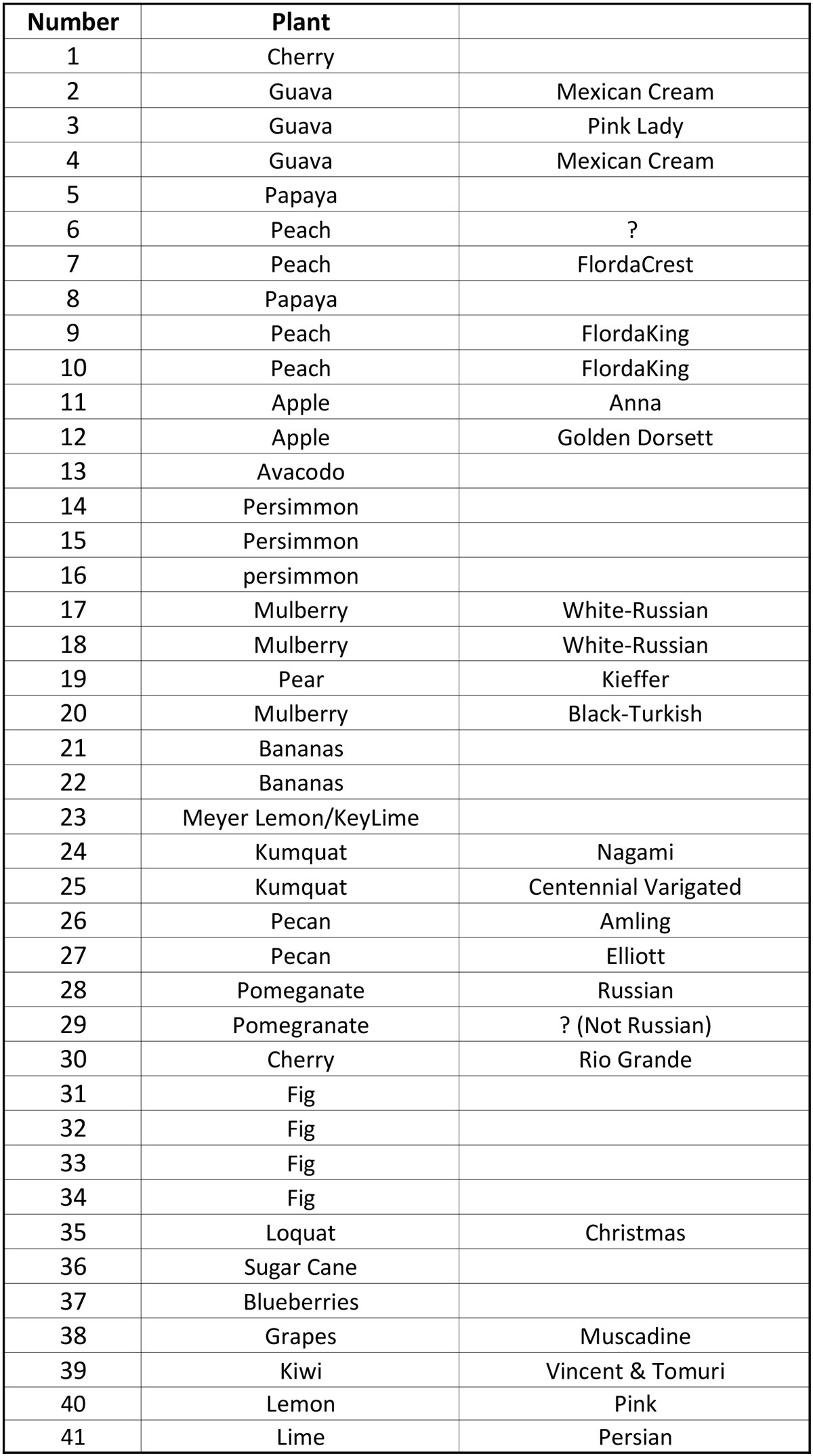
That’s some planning, there. I like it!
Food Forest vs. Orchard
My philosophy on growing gardens and trees in particular is “mix ’em up and stuff as many species into a space as possible!”
Don’t plant a citrus next to a citrus or an apple next to an apple. Plant them in a big mix and you’ll make the bad bugs work harder to make the jump from one tree to another. Apple pests usually only like apples, citrus pests usually like only citrus. Put gaps between the trees that are the same or even similar species and you’ll give things a little protection. To add more protection and good insects, throw in other edible, medicinal, insectary and nitrogen-fixing species. You can grow a ring of gingers in the shade of a loquat tree… or plant a chaste tree between fruit trees for medicine and to attract more bees. Cassias fix nitrogen and will improve the soil from below and from above as you cut them repeatedly for mulch. I share some species lists in the appendices of my book Create Your Own Florida Food Forest which will help.
The problem: if you can’t go “food forest” style, you’re looking more at a traditional orchard, which isn’t the easiest thing to grow in Florida. Florida wants to be a rambling, scrubby forest, so unless you have sheep, you’ll need to keep the grass down and mulch around the bases of the trees to get them established properly. Messy is better, unfortunately for those good people like your husband who want to keep things orderly.
As a husband myself, my advice is to do whatever he says. However, if you can talk him into letting you simply mulch the trees in big rings and plant some nice plants around their bases, you’ll be partway there.
I didn’t always pick plants and place them according to what I thought would be “perfect,” I just went for maximum diversity and food. If I was at the market and saw a butterfly plant I liked, I bought it and planted it next to one of my fruit trees. I did the same with herbs, flowers, vines and all kinds of roots. Anywhere I had a gap, I popped in a plant.
My place:
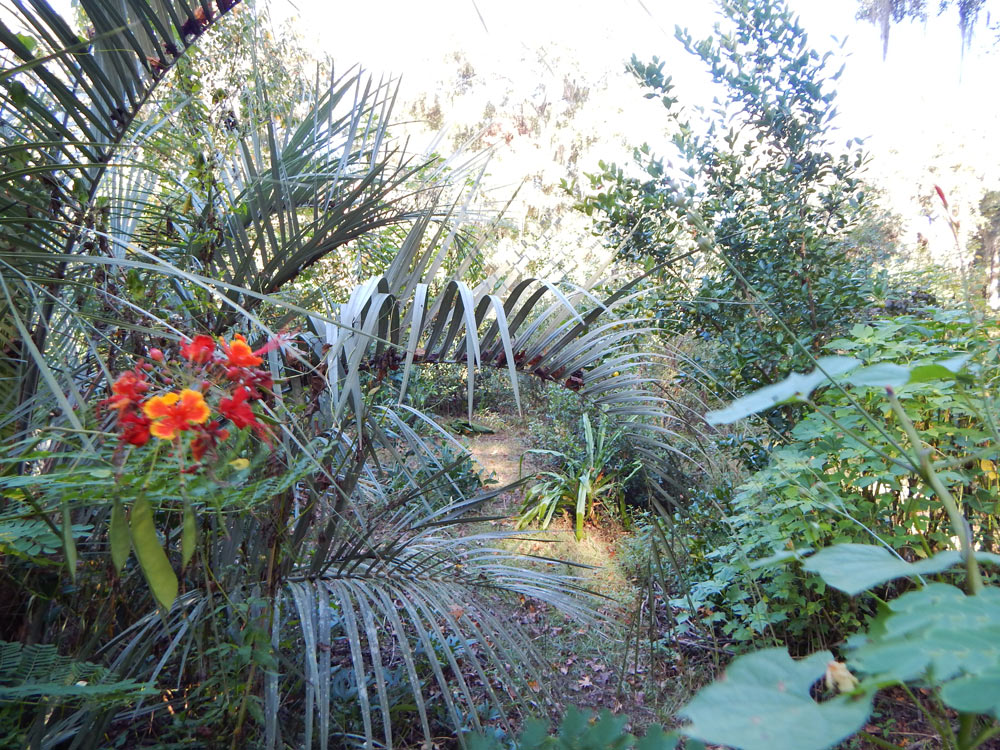
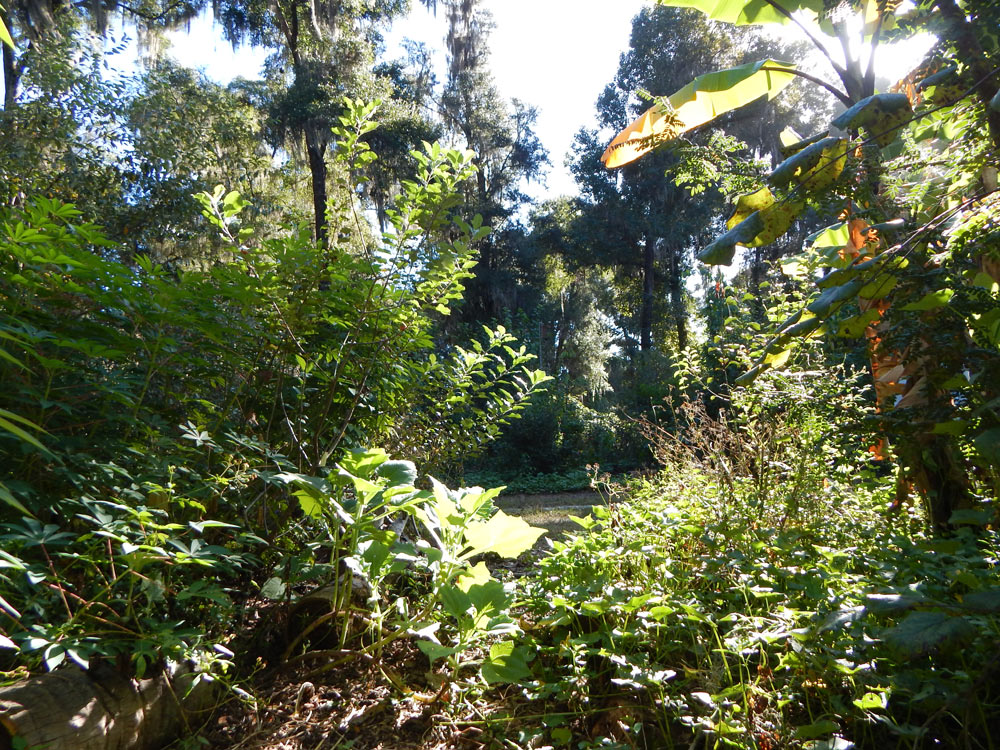
All we mowed were the paths and all the extra logs, leaves, clippings and other yard “waste” was piled on the sides of the path where they were rapidly consumed by vines and flowers and returned to the earth.
Jungle gardening like this will drive some people nuts… but boy was it easy and fun. I never knew what was going to pop up next or what rare species would appear spontaneously. So much life!
Now – judging by the plan, I’m assuming these trees are already all planted, so mixing up the species is no longer possible easily. My recommendation is to plant herbs, flowering shrubs and other perennials in “guilds” around each tree to add space for the good guys to live and to mix up the pests. More species = less problems, generally speaking.
What Plants are Must-Haves?
Okay – so what plants are “must-haves” beyond your current list?
If you have space, I would add the following plants:
Ginger (Good herb)
Lemon grass (Good herb)
Flowering almond verbena (Great for pollinators)
Chaste tree (Great for pollinators)
Mexican sunflowers (Tithonia diversifolia): Great for compost
Moringa (Marvelous for your health – many uses)
Chestnuts (Excellent tree! Get “Dunstan” trees)
Cassava (calorie crop)
African yams (calorie crop – vines will grow right up trees – plant by big ones!)
Chaya (GREAT green)
Milkweed (as many varieties as you can find – for insects!)
Here’s a subtropical fruit tree guild I created for another client:
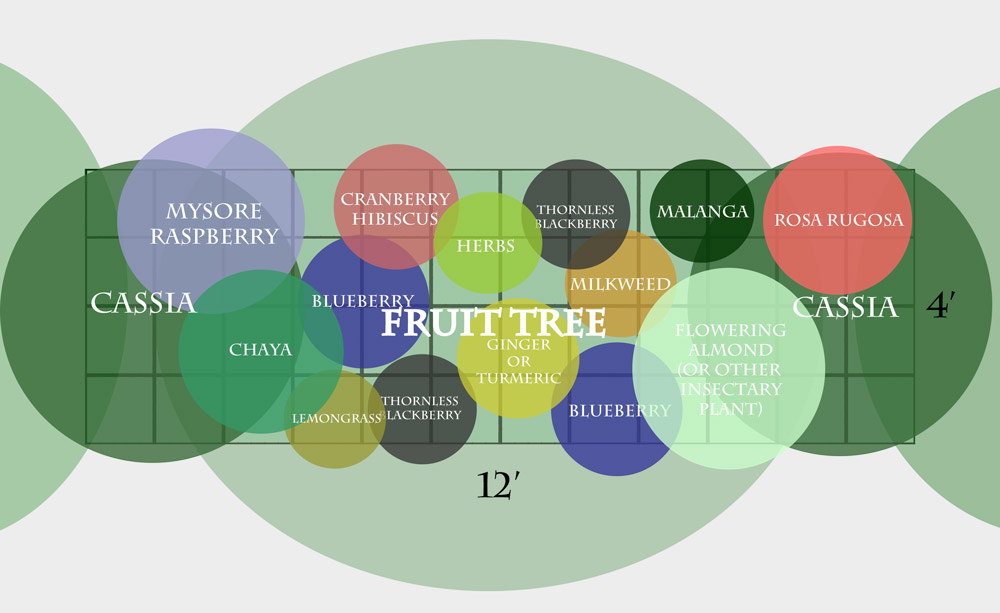
I realize some people like a lot of planning and want to know what they must plant. Guides like the one I created are helpful in this case but nothing is set in stone, just as nature itself is always changing. I add a lot and see what happens, but whatever you do – more plants and more species = good practice.
What Books Would Help?
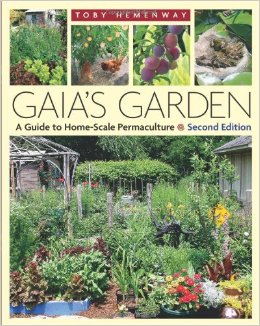 Since you already have my book Totally Crazy Easy Florida Gardening, I recommend checking out the book Gaia’s Garden.
Since you already have my book Totally Crazy Easy Florida Gardening, I recommend checking out the book Gaia’s Garden.Though it’s not a manual on Florida gardening, it will help you think in brand new ways about your yard and trees.
And one final question:
“Oh, and I have to ask… what did you graft your persimmons to? I ask because one of the persimmons I got from you was a mower casualty a looooong time ago, and it returned looking like a persimmon but the leaves are no longer glossy”
Mine were all on American persimmon root stocks, which may be male or female. You can graft the top without too much trouble if you do it in the spring – or just see if you get American persimmon fruit instead. Both are beautiful and useful trees.
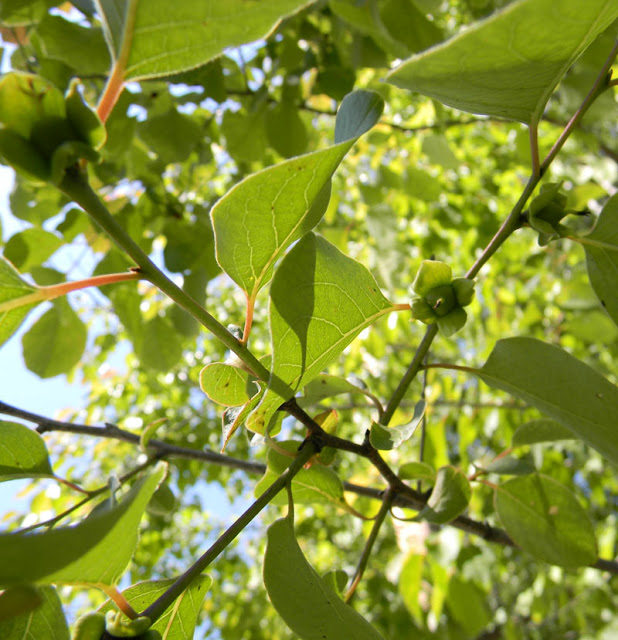
Female persimmon in bloom
Good luck on your projects and thank you for writing. Stop on by the forums any time to ask more questions of the sharp gardeners over there.
If you are another gardener reading this post and want some help, I am always available as a paid consultant if you need deeper advice and am happy to help.
Tomorrow I’ll share more on fertilizing that’s tailored to her yard and trees.


2 comments
Hi David, as usual great information. Maybe you could do a article on the Guanacaste tree, I have a couple big ones on my property here in East Central Florida, I’m sure you have a couple around where you are. I’ve heard they are a “nitrogen fixing tree” and that would be great news for me. Any help on how to use them or what the benefits of the tree would be awesome. Thanks again, now I have all your books and am looking forward to more. Scott
Thank you, Scott – I appreciate that a lot.
I haven’t posted much on the Guanacaste yet. That’s a great idea. They’re a marvelous nitrogen-fixer. Very powerful and they can also provide you with lots of compostable biomass. Chop and drop them again and again. Plant them all over the place!
Comments are closed.